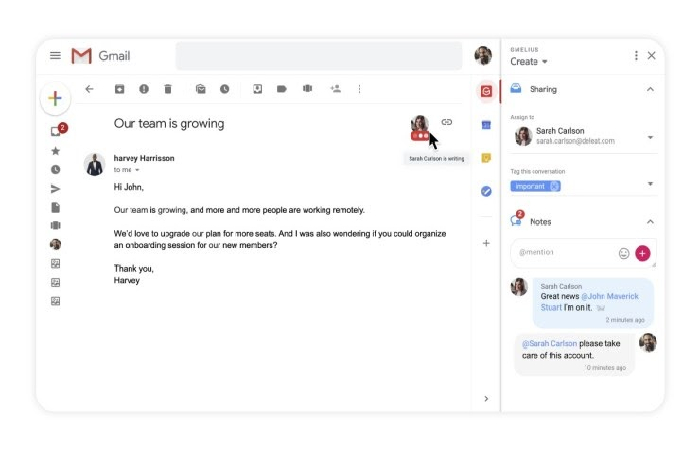Top-6 Advantages Of Using A Shared Inbox – Consider this scenario for a second: You are managing a team of content writers who are currently working remotely. Some employees have gone back to their hometown. You get the last-minute content edit project and need all-hands-on-deck. There’s an exhaustive list of guidelines to follow, and the deadline is ‘yesterday.’
In such a manic scenario where you are particularly pressed for time, do you think email would be the most optimal choice of communication? No, right? This is where having a shared inbox can save the day, which brings us to the next question:
Table of Contents
What Is A Shared Inbox?
Basically, a shared inbox (as the name suggests) allows more than one person to access, send, and monitor emails from the same email address using their respective inboxes. People across departments, locations, and functionalities will be able to collaborate on incoming mails, depending on whether they have access to it or not.
Now that we have a basic understanding of what a shared inbox entails, let us deep-dive into the primary advantages.
Top-6 Benefits Of A Shared Inbox
1. Facilitates One-To-Many And Many-To-One Conversations
Let us face it: CC’ing a thousand people or forwarding “FYI-type” mails is just ghastly. Not only does it clutter your inbox, but it also leads to time (and effort) wasted. And, of course, a lot of confusion. Enter: shared inboxes.
Since relevant people can access all incoming mails, this eliminates the need to forward the same mail over-and-over again. More importantly, people will be able to view the entire communication history so that they can collaborate with context and in real-time.
2. Acts As A Single Point Of Contact
Tying back to the previous point, shared inboxes act as a singular point of contact, driving seamless collaboration between team members. Since the team members won’t need to shuffle between inboxes, they will never miss out on any emails or other important communication.
It also helps external stakeholders such as your customers, partners, etc., reach out to connect with your company immediately instead of looking at your website/app/contact form/social media and finding the appropriate contact information, which can lead to frustration and annoyance.
3. Brings Transparency Throughout Teams
Another benefit of using a shared inbox is that it brings about greater accountability and transparency between teams. A clear and organized record of the conversation history means that:
- You won’t miss out on emails.
- There won’t be email duplicates.
- You won’t be sending out emails twice.
- You won’t need to waste time chasing after people for information.
- You’ll get instant visibility into any messages, notes, or comments that others may have.
4. Divides The Workload And Tracks Conversations
A shared inbox allows you to categorize your emails into useful buckets such as Sales, Customer Support, Information, etc. That’s not all. It also allows you to assign a specific email to a particular team member and add mail tags such as “Open”, “Pending,” or “Closed.” As you can imagine, this instills a sense of accountability and ownership among your team members.
Another important use case of using a shared inbox is this: Let’s say your marketing manager recently used a tool to host a webinar. At the end of the event, he ends up sharing his email ID to participants to encourage query resolution and get in touch should they have any needs. Naturally, he will experience a spike in emails. Now, instead of browsing through emails individually, it makes sense to create a shared email address such as marketing@yourcompany.com in your shared inbox so that the work can be divided among the team members. These individuals can be delegated different tasks and can help track important leads, conversations, and activities from the shared inbox. In addition to this, they can resolve customer queries instantly.
Finally, it also allows you to track and analyze important metrics such as response time, clickthrough rates, etc.
5. Enhances The Customer Experience
Contrary to popular opinion, shared inboxes do not create chaos and confusion when dealing with customers. Since individual team members can be assigned specific tasks and be individually responsible, the chances of having different team members responding to the same customer multiple times gets redundant. Take, for instance, the following example of Gmelius. It allows team members to view each other’s avatars if a particular member is browsing through an email. In fact, the onlooker can also see a ‘red ellipsis,’ which pulses in real-time, indicating that the person in question is replying to the email. This eliminates the chances of two colleagues responding at once:

6. Improves Productivity As Well As Responsiveness And Improves Speed
The beauty of shared inboxes is that it is super-flexible and easy to set up. Plus, you can extract a lot of value from your inbox by setting up different sections and driving diversified work such as customer support, billings, media and press, partnerships and collaborations, and so on. Additionally, since everyone is literally on the same page information-wise, it drives better team engagement, responsiveness, and efficiency.
Furthermore, you can also review everyone’s mails and establish best-practices so that everyone is constantly learning. Naturally, this means that you will end up working more productively and with greater speed.
For instance, if you have a business that develops online courses to sell to the public, it’s likely that many of the courses you create have a lot of work that goes into them. Not only do you need to develop a course framework, but many times there are videos that need shooting, editing, transcribing, and posting to the course itself. When you have a course instructor, editor, transcriber, and course manager all in the same inbox, it can help save a TON of time in exchanged emails as a course is built.
Final Words
Long story short, shared inboxes are perfect for teams looking to collaborate at scale and with greater transparency. It also allows cross-functional teams to work with greater synchronicity. And is ideally suited for organizations that like to adapt to modern workflows and keep up with the latest technology. If used correctly, a shared inbox can save on people’s time and effort and drive a culture of accountable togetherness.
Thoughts?

Linkedin: https://www.linkedin.com/in/ashwini-dave/
Twitter: https://twitter.com/AshwiniDave1

